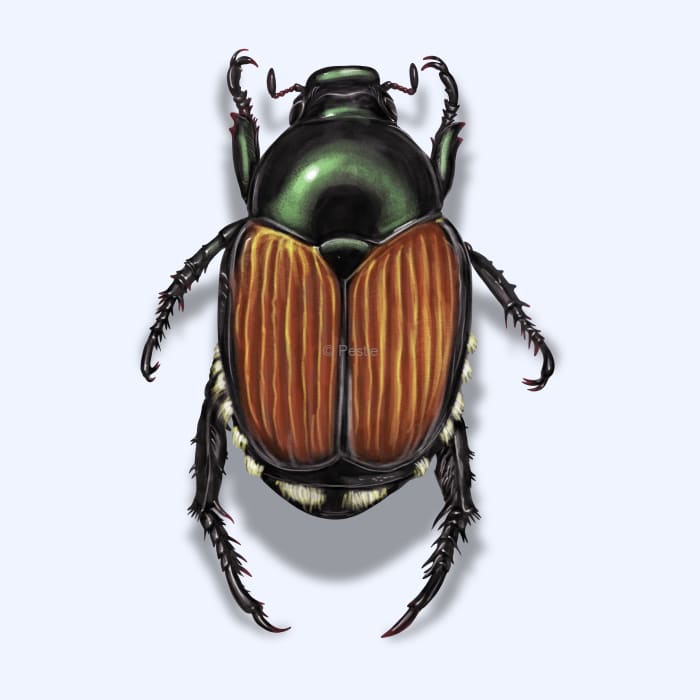How to identify and get rid of Japanese beetles

Japanese beetles: the beautiful destroyer of plants
While you’re admiring their metallic sheen and shiny colors, Japanese beetles are busy chewing up your favorite plants. They are an invasive species that came from Japan through plant nurseries back in 1916 in New Jersey and have slowly been spreading east ever since.
These beetles are known to eat over 400+ types of plants, feeding on leaves, flowers, and fruit. The adults skeletonize leaves, eating between the leaf veins, and the grubs are pests of turfgrass roots.
How to identify Japanese beetles
Japanese beetles are small, colorful scarab beetles that are oval in shape and metallic green and copper in color. The adults have a hard shell, called an exoskeleton, that is covered in tiny hairs. The underside is black with rows of white tufts of hair.
Here are some key characteristics of Japanese beetles:
- Metallic green head and thorax
- Copper-brown wing covers (elytra)
- 5 white patches of hair on each side
- 2 white tufts of hair on the tip of abdomen
How big are Japanese beetles?
They are about 1/3 to ½ long, about half the size of a penny.
What other beetles look like a Japanese beetle?
Several insects could be confused with Japanese beetles. These include May and June beetles, chafers, and some stink bugs.
The most distinguishing feature of the Japanese beetle is its white tufts of hair around the abdomen. Other look-alikes won’t have these tufts.
Where do Japanese beetles live?
They are originally from Japan but aren’t considered pests there due to natural predators that keep their numbers low. However, after being introduced into the United States in 1916, they have spread to most states east of the Mississippi River, and into the west as far as Colorado and the Dakotas.
How to get rid of Japanese beetles
When it comes to controlling Japanese beetles, the earlier you start, the better! Manually picking off Japanese beetles and dropping them into soapy water is very effective if you have a few susceptible plants. You can also place netting over non-fruiting plants to protect them from chewing damage. Usually, Japanese beetle feeding is done by mid to late August.
You can also reduce their emerging numbers by not irrigating your lawn during the midsummer months. The grubs thrive in moist soils but are susceptible to drying out.
Finally, don’t place pheromone traps around your home or garden. These are popular items sold in hardware stores or garden centers. While the traps are effective at luring in Japanese beetles, you will essentially attract your neighbor’s beetles into your yard, and not all the beetles will fall into the trap. It’s more or less a beacon to surrounding Japanese beetles to invade your property!
Treat japanese beetles with Pestie
If you're still having trouble keeping japanese beetles away, the best option is to use a pro-grade, effective pest control solution like Pestie.
Pestie is a do-it-yourself pest control solution that's specially designed to keep japanese beetles and other pests away from your home.
With Pestie, you can rest easy knowing that your living space is protected and free of creepy crawlies. And the best part? It's designed for people, pets, and the planet, so you can say goodbye to harsh chemicals and hello to peace of mind!
- Save hundreds compared to traditional annual pest plans
- People, pet, and planet-friendly
- Pro-grade customized formulas
Quick facts
- Scientific name
Popillia Japonica
- Colors
Metallic green and copper-brown
- Life span
12 months
- Diet
Leaves, flowers, fruit of over 400 species of plants
How dangerous are Japanese Beetles?
Low danger risk
Japanese beetles don’t carry any diseases or cause any harm to humans or pets.
Japanese beetles stick out their hind legs when they are threatened. This is believed to be a way to ward off predators.








